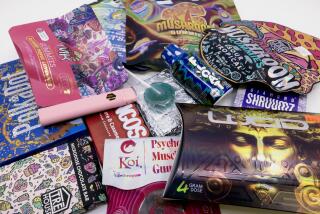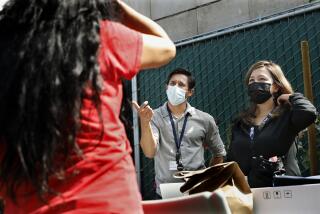In New York, late nights are fueled by party drug Molly
NEW YORK â After a long and raucous dinner party on a recent weeknight, guests decamped to a loft in Manhattanâs TriBeCa neighborhood, perhaps the most desirable chunk of real estate in the city that never sleeps.
There was no music or dancing at this after-party, though. Instead, a host distributed clear capsules of tiny white crystals that guests proceeded to swallow â an illicit dessert known as Molly, a synthetic stimulant that has suddenly become as much a part of the 24-hour-a-day New York lifestyle as cocaine was to another generation.
In this case, two financiers at the party had just completed a multimillion-dollar pact, a cause not only for celebration but for bonding of the kind that only can occur in the netherworld after 3 a.m. Later that morning, everyone drifted out to go to work.
âIn todayâs era, everyone is popping pills,â said a fashion company owner who was one of the guests but who feared using her name could put her job at risk. âEveryone wants to come to New York and succeed, but thereâs so much pressure, so much competition. ... With Molly, youâre happy, youâre free, thereâs no worries, no negative talk.â
Molly is marketed as a pure form of MDMA, the main ingredient in the street drug Ecstasy. Often associated with electronic dance festivals and shilled as a âsafeâ high, it is gaining fans across the country. But the national Drug Abuse Warning Network noted a 120% increase in the number of emergency room visits involving MDMA from 2004 to 2011.
Public health officials say the drug is often not as pure as its marketing claims, and its effects are increasingly proving fatal. Two people died at the New York Electric Zoo festival over the Labor Day weekend after ingesting Molly, and at least four others were hospitalized in critical condition. Two other deaths that weekend, one in Washington state and the other in Boston, were also attributed to the drug.
Molly was a fixture at this yearâs Coachella Valley Music and Arts Festival, and is increasingly part of the Los Angeles club scene. Sam Torbati, co-chairman of the Department of Emergency Medicine at Cedars-Sinai Hospital, said Southern California physicians had seen an uptick in patients who had used Molly or MDMA, though precise numbers had not been compiled. In San Francisco, MDMA-related emergency room visits were up 30% between 2008 and 2011.
Molly seems to have especially captivated New Yorkers, who use it to keep up in a fast-paced city where both parties and work obligations can regularly run into the wee hours of the morning, and yawning is frowned upon. Faced with the pressures of living in an exhausting city, some New Yorkers say they use Molly to help them keep up with life. Itâs a dangerous proposition: Emergency room visits here of people who say they have taken MDMA doubled between 2008 and 2011, a much higher rate of increase than that in other U.S. cities.
âWe are definitely seeing an increase in the number of people who say theyâve taken Molly,â said Dr. Theodore Bania, director of research and toxicology at the emergency departments of St. Lukeâs and Roosevelt hospitals in New York.
Some Molly enthusiasts could be found on a recent Thursday night at a hub for night owls: the New York club Marquee, where doors donât even open until 11 p.m. Lights flashed red and blue as an earsplitting beat rattled an ever-more-crowded dance floor. There was no room for the weary: Tables were reserved for groups that had spent thousands of dollars on bottle service; everyone else had to stand, or better yet, dance.
One clubgoer, Zack Daniels, 20, said knowing he could look forward to that âpure, happy momentâ that came with Molly helped him get through the daily indignities of life in New York. It sustained him through a tough patch when his mother was very sick, he said, and helps him appreciate music festivals he might otherwise dislike.
âIt makes me lose all my worries, and forget why I wake up and donât want to go to work, and why I hate the subway, and why I hate homeless people asking for money,â Daniels said as throngs of men, many shirtless, pushed their way up and down the crowded staircases that link the clubâs two levels. âIt makes me forget all of that and just appreciate the good things in life.â
Onstage, dancers in feathered headdresses gyrated next to someone in a black and white mime costume. The clubgoers were hard to distinguish from the entertainers â one woman was walking around in a bra and underwear, and another man danced happily by himself in a sparkling white robe. People could be heard shouting over the music, asking whether others âknew Molly.â
Jean Mone, a therapist and substance abuse counselor in New York, says that in the last year or two, more of her clients have mentioned using the drug. They range in age, but some of them are in their early 20s and take the drug to stay up all night and blow off steam after long, demanding days at work. Some take Molly to stay up at night and then pop Adderall, another stimulant, to get up in the morning and go to work.
The uptick in Molly abuse, in Moneâs view, is the result of a collision with reality as âGeneration Meâ comes of age, expecting everything out of life and not wanting to compromise when there arenât enough hours to do it all.
âThereâs this pressure placed on them to do well at work, keep up with their job, and at the same time, they want to socialize,â Mone said.
On New York Craigslist, there were numerous listings from dealers selling Molly for $100 a gram. âPure crystals!!!!â one ad proclaims. âMollyâs here with me!â says another.
MDMA is not a new substance. It was used in the 1970s and 1980s for psychotherapy, primarily for couples having difficulty making connections and people who needed help opening up. Itâs still used in experiments to help patients with post-traumatic stress.
The drug earned a bad reputation in the 1980s and 1990s when it was marketed as Ecstasy but often came mixed with other dangerous chemicals, leading to deaths and hospital visits. The same thing is happening now with Molly, which is marketed as a pure form of MDMA, but is often mixed with other substances in the labs where it is made, said Dawn Dearden, a spokeswoman for the Drug Enforcement Administration.
âEven though it comes in this cute foil package, you have no idea what comes in that package,â Dearden said.
Sen. Charles E. Schumer (D-N.Y.) in September urged the federal government to crack down on Molly, and the New York state Assembly recently approved a bill increasing the penalties for people who sold chemical compounds such as Molly.
That worries people such as Rick Doblin, a researcher and founder of the Multidisciplinary Assn. for Psychedelic Studies, a California group that advocates for marijuana and psychedelic drugs to be used in a clinical setting. Though Molly can be dangerous, it also has an important role in therapy, he said, and has been used on hundreds of patients since the 1970s. His group is hoping to get Food and Drug Administration approval for MDMA as a therapeutic drug by 2021.
âIn this digital age, people want human emotion, they want to celebrate communally,â Doblin said. âPeople are hungry for this type of experience.â
Many New Yorkers say the drug is already so widespread that cracking down on it could be tough. âPeople do it all the time,â said Alex, a Wall Street financier who declined to publish his last name. Standing in a bar in the heart of the financial district, he said he attended a recent media and advertising conference where Molly was served up at the after-party.
Now, it was late on a weeknight, and Alex â who, like most everyone else in the bustling bar, was still wearing an expensive suit from the previous dayâs work â had to be back at the office early the next morning. Still, he had no immediate plans to go home, nor did he seem to worry much about repercussions at work if he was caught having danced with Molly. Who would complain?
âEven the bosses do it.â
More to Read
Sign up for Essential California
The most important California stories and recommendations in your inbox every morning.
You may occasionally receive promotional content from the Los Angeles Times.











